Lessons Learned Building A Productized Service
It’s been three years since I launched my productized service. And, boy, did I do a lot of things wrong!
But I’m glad I did. If it weren’t for the many mistakes I’ve learned from and lessons I’ve applied, my business never would have grown to replace my income as a freelancer.
As it turns out, I wasn’t alone in my mission to move away from client work and into a products business. Every day when I read the replies I get from freelancers who read my newsletter, most tell me they want to do the same but that making the transition seems almost impossible.
Well, let me tell you: It isn’t easy. And it won’t happen overnight. And it most certainly won’t happen if you’re not willing to make plenty of mistakes and to learn from them.
After all, that’s what we do! We learn by doing, and we figure out what we need to as we go. I believe this is our unique advantage as designers, developers and builders: We already have the learn-by-doing mentality engrained in us from years of building websites. So, when it comes to building a business, we can apply that same approach.
Today, I’m proud to own and operate a business that does not revolve around billing for time. Instead of writing proposals and taking on client work to pay the bills, I’m building an asset that grows in value year after year.
In this article, I’ll share five key lessons I learned from making this transition. I’ll share the story of how I iterated and improved the business because of them. My goal here is to show you that you can still find success by doing a lot of things wrong. That’s how you level up from freelancing to owning a thriving, growing business.
Now, let’s go back to the beginning. Where did things go wrong, and how did I right the ship?
Focus On Conversations, Not Analytics
One of my key lessons, which led to all of the others I’ll describe below, was to base my decisions on actual conversations with customers.
Looking back, I spent way too much time in analytics tools, rigging up the perfect metrics dashboard. I tried a lot of them, like Google Analytics, KISSmetrics, Mixpanel, DigMyData and others. These worked well for generating reports, but that didn’t become very useful until later.
Through the first year and beyond, my conversations with customers are what led to the most actionable insights. Luckily, I spent an enormous amount of time manning the live chat widget on our website, answering emails and getting on the phone with any customers who wanted to.
It is in these pre-sales conversations that you’ll hear questions, requests and objections. After 10 conversations, a few interesting ideas surface. After 100 conversations, the right direction becomes smack-you-over-the-head obvious.
For example, when customers repeatedly asked about online ordering, I knew that was a key added value worth exploring. So, I added online ordering in 2013 and sales grew faster.
Conversations with customers have really helped with marketing, too. For example, I learned that our customers (restaurant owners) aren’t familiar with terms like “responsive web design.” But they will often ask, “Will it work on my smartphone?” So, I changed our copy from “Optimized for mobile using responsive web design” to “Works on any smartphone or tablet.”
Try This
Install a live chat tool (like Olark) on your website, and make sure that you, the founder, are the one taking chats, especially in the early days. You’ll be amazed at the insights you gain.
Now, I know that adding a live chat widget might go against your taste in usability and a clean layout. They can be annoying and are considered by many to be useless, but in our case they proved to be very valuable. I, too, had these misgivings about adding clutter to my website. I weighed the following pros and cons.
Cons of live chat:
- It could come across as overbearing or downright annoying to our visitors.
- The look and feel of the widget might not match the website’s aesthetic.
- It will distract from the content of the page.
Pros of live chat:
- We can customize when and where the widget pops up (or keep it closed until a visitor engages with it).
- We can customize the look of the widget to match our colors and style.
- It opens the door to conversations with potential customers that we otherwise wouldn’t have had.
It was that last reason — sparking more conversations — that sealed the deal for me. And I’m glad it did. Today, we have 30 to 50 meaningful conversations with potential customers via live chat every month. That’s not a large number compared to our overall traffic. But those conversations often lead to new customer registrations.
In the early days (and still today), these live chats have given us valuable insight into the key questions that our customers are asking. Without this knowledge, we wouldn’t be able to write effective copy or choose the right features to focus on.
We’ve even had customers offer their phone number via live chat and ask us to call them. I highly recommend taking these conversations offline and onto the phone, if possible. This not only helps to land more sales (as I’ve learned), but really helps you learn more about your customers and the language they use to describe your product. Your product, your marketing and your new business will be benefit greatly from these insights.
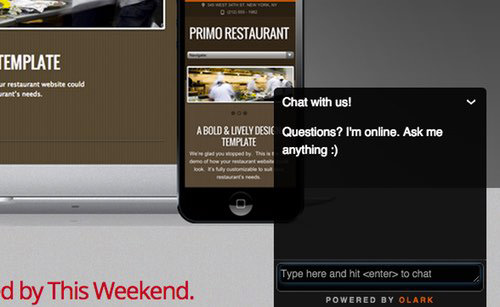
“Done For You,” Not “Do It Yourself”
When I set out to build my first SaaS (software as a service), Restaurant Engine, my dream was to create a product that was completely self-serve. Automatic. I hoped it would magically get customers to show up and sign up and that they’d use the included tools and happily pay their bill every month. A dreamer can dream, can’t he?
I spent thousands of dollars and about six more months than I should have, pulling all-nighters to build an entire DIY website builder on WordPress.
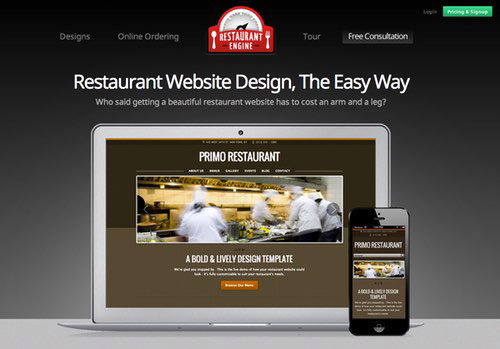
As I launched out of beta, those first few months were slow. A few early customers signed up. A couple more trickled in over the next few months. But I wasn’t seeing the rocketing growth I had hoped for out of the gate.
I spent a large part of the first year working on improvements to the user experience, making it even easier to use. But that didn’t move the needle. Not enough people were signing up, and most of those who did became frustrated or too busy and canceled.
The key realization came when I noticed a trend in my presales conversations with potential customers. Many of them asked, “How much for you to set up my site for me?”
I realized what the true roadblock was: Our market (restaurant and hotel owners) doesn’t want a DIY website builder. They just want websites designed for them, quickly and affordably, so that they can focus on running their business.
So, I introduced a complementary setup service. This included inputting all of the content (food menus, photos, etc.), making it all look awesome and connecting their domain name.
This “done for you” service was the first change that made an impact. For the first time, the business offered a unique added value that helped to overcome the most common objection: that customers simply didn’t have the time, nor did they want to create the website themselves.
Try This
Consider offering a complementary or low-cost “concierge” service to encourage new customers to get on board. Forget about building in automation, especially in the early days.
A great example of this is the email marketing service Drip. As a way to help new customers get started quickly, the guys at Drip will create your email autoresponder sequence for you!
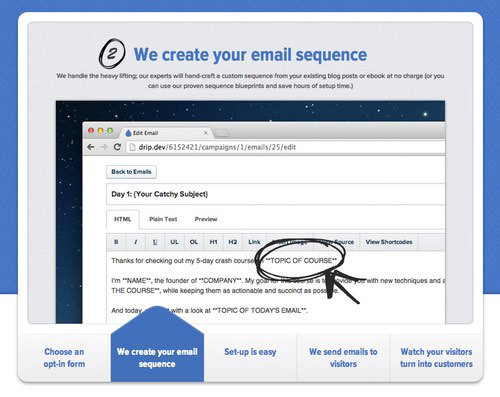
Need more convincing on this one? Look no further than Paul Graham’s fantastic essay “Do Things That Don’t Scale.” In it, he writes:
"If you can find someone with a problem that needs solving and you can solve it manually, go ahead and do that for as long as you can, and then gradually automate the bottlenecks."
Charge For Setup And Require It
Once I added our complementary concierge setup service, I noticed a significant improvement in registrations and retention. But it also brought new problems.
Manually setting up a customer’s website is costly, especially when they have a lengthy food menu and a lot of content. Our process was streamlined quite a bit, thanks to the customization features I had built in from the start. But the setups became a huge bottleneck.
The business recouped that cost within the first 60 days of a customer’s subscription. But for those customers who ended up cancelling, it was a significant loss. So, I introduced a small fee to the “done for you” setup service, which was optional at the time of registration. I was pleasantly surprised that more than half of our new customers opted for the paid setup.
So, the cost problem was solved. But charging for the setup had a positive impact in another unexpected way: Customers who opted for the setup were far more engaged in the process and encouraged to stick with the service. This meant that the cancelation rate for those customers fell to nearly zero.
For almost a year, I clung to the idea that there should be a DIY option. That turned out to be a costly mistake. Many of the customers who chose that option ended up cancelling, despite our proactive efforts to offer support.
Eventually, I recognized this was a major leak in our funnel. So, I decided to make the manual setup service required for all new customers. This meant I had fully embraced the idea that the business is a productized service. Customers are onboarded manually, and I still manage to scale the business by focusing on systems and by streamlining our process.
Try This
What if you charged for your service up front? Sure, that might mean a lower rate of registrations, but it could also attract better, more valuable customers.
If you’re running SaaS or selling a product, consider adding a required, paid setup service. For example, Infusionsoft charges thousands for its initial service. This turns away a lot of potential customers, but it also ensures that those who join, stay.
If you’re freelancing and risking a lot of time on discovery meetings and writing proposals, then try proposing a paid discovery process. For a small fee, you can sit down with your client and scope out their project. This gives the client something of value (a clear roadmap and specification), and it ensures that you’re paid for your time.
Ask For Consultations, Not Registrations
You may be seeing a pattern. Over time, I moved the business away from self-serve automation to a more hands-on service. This was true not only for the product, but for marketing as well.
For a long time, I positioned the website and all of the marketing toward getting people to sign up for an account. All of the call-to-action buttons pointed visitors to the sign-up form. I ran various campaigns that did the same.
Over time, I noticed that many customers needed two to four interactions via email, live chat or phone in order to feel ready to sign up.
For a long time, the business lost many potential customers because of this. I can assume that only a fraction of visitors who had questions actually took the time to reach out and ask. And we didn’t have an easy way to follow up with a person after the first interaction, especially because the website didn’t capture an email address or phone number.
I finally made the decision to shift our strategy away from asking for registration right away, instead encouraging visitors to request a consultation. This was huge. It enabled me and my team not only to call and follow up with people who’ve shown interest (which I already knew helps drive sales), but to further develop and optimize this process.
For example, in addition to getting on the phone and personally following up with every new lead, I also built automated email sequences tailored to the person’s interests. These helped to teach them about key benefits over the course of a three-week (give or take) sales cycle. I go into much more detail about how I have optimized our sales process in my post “A System for Selling.”

Try This
If you’re having trouble getting visitors to sign up for your service or to purchase a product, try changing your call to action. Instead of pointing to your purchase page, encourage visitors to request a free consultation.
First and foremost, you’ll be talking on the phone with potential customers and learning more about their needs and objectives. These insights are pure gold when you’re just starting out.
Plus, you can enhance your consultation with an offer like a free webinar or email campaign. This way, you can build a stronger relationship with new leads before asking for the sale.
It’s Not SaaS: It’s A Productized Service
As you can see, thanks to the many mistakes and iterations I’ve made along the way, the business turned into something much different than I had originally envisioned.
I started out with the goal of building SaaS. But as it evolved, I learned that the value was not so much in the software part, but rather in the service. A more accurate way to describe the business today would be a productized service.
It’s largely built around manual processes. We personally talk to and follow up with every visitor who requests a consultation. We then manually set up every new customer’s website, input all of their content and make customizations. We even offer “done for you” ongoing support. This means that when customers want to make a change to their food menu or swap in a new photo, we don’t just answer questions on how to do that, we’ll make the change for them, as a complementary feature of our service. This “done for you” approach adds tremendous value and helps our customers succeed.
I can hear you thinking, “But can it scale?”
My answer is a resounding yes. That’s one aspect of my mission that hasn’t changed since day one. I simply needed to adjust what I thought it means to scale.
The more I moved the business toward doing things manually, the more I focused on systems and procedures and on streamlining our processes. This has allowed me to delegate all tasks involved in serving our customers to my (amazing!) team. I’m free to focus on the bigger picture and on strategic direction. In other words, instead of scaling with software and automation, we’re scaling with processes and people.
Since moving my business in this direction, I’ve come across many others who are finding success with productized services, such as productized consulting.
For example, with his service Draft Revise, Nick Desabato will perform a monthly A/B test on your website to help you improve conversions.
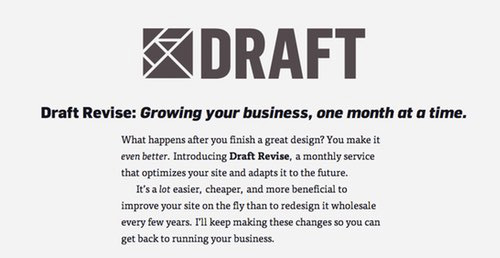
Jarrod Drysdale recently launched Landing Page in a Day, where, as you might guess, he helps you launch a landing page in one day.
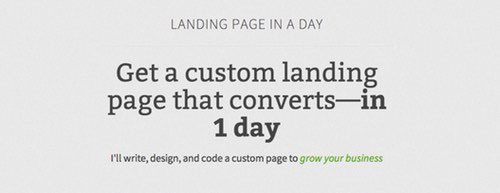
Those are just two examples of freelancers who have escaped the typical hourly billing model. Many others have gone the productized consulting route or are looking to productizing as a path to scaling and growing a team, as I’ve done with Restaurant Engine.
Other Resources
- “Productize Your Service,” Brian Casel As you can see, through many mistakes and lessons, I’ve come to fully embrace this productized service model. In doing so, I’ve broken free of the typical freelancing model. I teach freelancers how to do the same in this free crash course.
Have questions or care to share a mistake or lesson you’ve learned in the past year? Let’s hear it in the comments!
Further Reading
- Conversational Design Essentials: Tips For Building A Chatbot
- Finding Better Mobile Analytics
- How To Build A Real-Time Commenting System
- How To Develop A Chat Bot With Node.js








